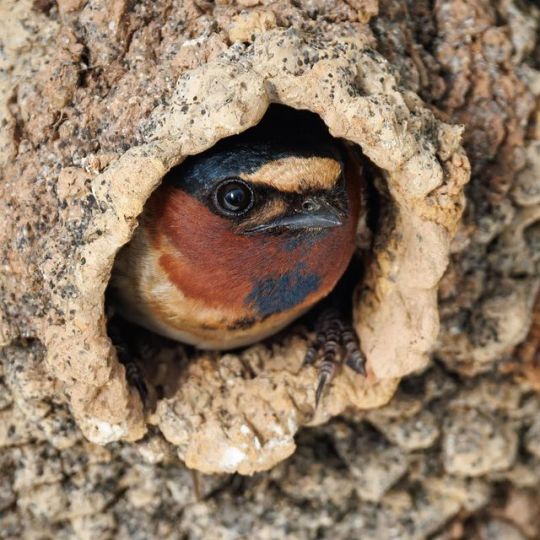#petrochelidon pyrrhonota
Explore tagged Tumblr posts
Text

Migratory May day 25: Cliff Swallow
Reference photo by Caleb Putnam
Inks and lineless variant under the cut:


#migratory may#cliff swallow#swallow#petrochelidon pyrrhonota#petrochelidon#hirundinidae#passeriformes#ornithology#bird#birb#birds#birbs#bird art#art#digital art#artists on tumblr#tw eyestrain#cw eyestrain#wauk wauk
52 notes
·
View notes
Text
BOTD: Cliff Swallow

Photo: Becky Matsubara
"This swallow is probably far more common today than when the Pilgrims landed. Originally it built its jug-shaped mud nests on the sides of cliffs. However, the sides of barns and the supports of bridges provided sheltered sites that were far more widespread than the natural ones. Taking advantage of these artificial locations, the species has invaded many areas where it never nested before. Although it is continuing to spread in the east, it is still more common in the west, where practically every culvert and highway bridge seems to have its own Cliff Swallow colony."
- Audubon Field Guide
#birds#cliff swallow#birds of north america#north american birds#swallows#passerines#birds of the us#birds of canada#birds of mexico#birds of central america#birds of the caribbean#birding#bird watching#birdblr#birblr#bird of the day#Petrochelidon pyrrhonota
64 notes
·
View notes
Text

Cliff Swallow
88 notes
·
View notes
Text

Hirundo rustica | Progne subis | Petrochelidon pyrrhonota | Chaetura pelagica | Tachycineta bicolor
Plate XVIII | Die Nordamerikanische Vogelwelt (1891)
#bird art#bird illustration#vintage art#vintage illustration#artists on tumblr#hirundinidae#hirundo rustica#barn swallow#progne subis#purple martin#petrochelidon pyrrhonota#cliff swallow#chaetura pelagica#chimney swift#tachycineta bicolor#tree swallow
13 notes
·
View notes
Text

Cliff Swallow
Virginia, June 2024.
0 notes
Text
Cliff swallows, grey wolf, rocky mountain goats, blue winged teal, steller's jay, osprey, Barrow's goldeneye
#petrochelidon pyrrhonota#nature#birds#aminals#oreamnos americanus#canis lupus#spatula discors#cyanocitta stelleri#pandion haliaetus#bucephala islandica#mammals
0 notes
Text

Migrating swallows, Santa Ana National Wildlife Refuge, Hidalgo County, Texas. From left: Cliff Swallow (Petrochelidon pyrrhonota), Barn Swallow (Hirundo rustica), and Tree Swallow (Tachycineta bicolor).
502 notes
·
View notes
Text


Cliff Swallow Petrochelidon pyrrhonota
6/16/2023 San Diego County, California
#baby birds#baby animals#nestlings#nest#bird nest#cliff swallow#swallows#swallow#nests#bird#birds#bird photography#birblr#wildlife#wildlife photos#wildlife photography#nature#nature photos#nature photography#birding#birdwatching#birding photos#my photos#california#california wildlife
242 notes
·
View notes
Text

American Cliff Swallow (Petrochelidon pyrrhonota) getting a drink on the wing, family Hirudinidae, found across much of North America in the breeding season, and South America in northern winter.
photograph by @kristinbrown1
111 notes
·
View notes
Text

[https://www.inaturalist.org/observations/14216689] Cliff Swallow || Petrochelidon pyrrhonota Observed in Canada Least Concern in location of observation
18 notes
·
View notes
Text

Cliff Swallow
Petrochelidon pyrrhonota
#wildlife photography#bird#nature photography#animals#my photos#nature#swallow#cliff swallow#birding#birdwatching#original photography#photographers of tumblr
17 notes
·
View notes
Text

cliff swallows (petrochelidon pyrrhonota) - may 2024
11 notes
·
View notes
Text

Cliff Swallow (Petrochelidon pyrrhonota)
After years of trying I finally got a decent picture of one of these guys.
Absolute nightmare to photograph in flight, they're so small and they move SO FAST, the camera autofocus just can't keep up and tries to focus on the background instead.
So the best way I've found is to just focus on their nests and wait for birds to fly onto the screen and hope that the autofocus works fast enough lmao.
#Not Pets#Wildlife Photography#Cliff Swallow#Hopefully I can go out again tomorrow evening and try for better shots.
4 notes
·
View notes
Text

Cliff Swallow
15 notes
·
View notes
Text
Introductory Posting
Greetings foes, friends and others. The islands of Hertford and Ciboux are the component islands of the Bird Islands Wildlife Management Area. They are located approximately 4-5 kilometres from Cape Dauphin, Victoria County, Cape Breton, Nova Scotia, Canada, North America, Earth. The Bird Islands are located at 46.376°N, 60.384°W, with an altitude of 0 - 20 metres and a total area of 10.89 square kilometres. Hertford Island is approximately 1.1 kilometres long an 120 metres wide, while Ciboux Island is approximately 1.6 kilometres long and 120 metres wide.
The Bird Islands have the largest colony of Great Cormorants (Phalacrocorax carbo) in North America. The Bird Islands also have the greatest concentrations of Black-legged Kittiwakes (Rissa tridactyla), Razorbills (Alca torda) and Atlantic Puffins (Fratercula arctica) within the province of Nova Scotia. They also have many other bird species including Double-crested Cormorants (Phalacrocorax auritus), Black Guillemots (Cepphus grylle), Leach's Storm Petrels (Hydrobates leucorhous), Spotted Sandpipers (Actitis macularius), Cliff Swallows (Petrochelidon pyrrhonota), Herring Gulls (Larus argentatus), Greater Black-backed Gulls (Larus marinus), Great Blue Herons (Ardea herodias), and Bald Eagles (Haliaeetus leucocephalus) as well as animals which are not birds such as the Grey Seal (Halichoerus grypus). The flora consists of shrubs as well as areas of grass and other forbs.
Hertford Island is currently owned by the Nova Scotia Nature Trust (previously by the Nova Scotia Bird Society), while Ciboux Island is owned by the province of Nova Scotia and the federal government of Canada. The name Ciboux is from the word Cibou, from the Mi’kmaq sipu, meaning river. The name Hertford is most likely named after one of the many other places, people and other things named Hertford.
The blog is not legally the official blog for either of the islands of Hertford or Ciboux.
#Introductory Post#Hertford#Ciboux#Hertford and Ciboux#Gimmick Blog#Yellowlegs are also found here but I couldn't find whether it was the Greater Yellowlegs (Tringa melanoleuca)#or both#European Starlings (Sturnus vulgaris) can also be found here but they are a non-native species and are causing problems
0 notes
Text

Migrating swallows, Santa Ana National Wildlife Refuge, Hidalgo County, Texas. From left: Cliff Swallow (Petrochelidon pyrrhonota), Barn Swallow (Hirundo rustica), and Tree Swallow
1 note
·
View note